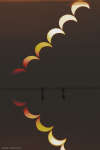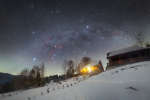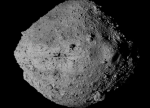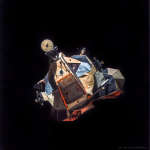
|
Astronomy Picture Of the Day (APOD)
 A Partial Solar Eclipse Sequence Reflected
A Partial Solar Eclipse Sequence Reflected
27.12.2019
What's happened to the Sun? Yesterday, if you were in the right place at the right time, you could see the Sun rise partially eclipsed by the Moon. The unusual sight was captured...
 The Northern Winter Hexagon
The Northern Winter Hexagon
26.12.2019
December's New Moon brought a solar eclipse to some for the holiday season. It also gave beautiful dark night skies to skygazers around the globe, like this moonless northern winter night. In the scene, bright stars of the Winter Hexagon along the Milky Way are rising.
 An Annular Solar Eclipse over New Mexico
An Annular Solar Eclipse over New Mexico
25.12.2019
What is this person doing? In 2012 an annular eclipse of the Sun was visible over a narrow path that crossed the northern Pacific Ocean and several western US states. In an annular solar...
 A Northern Winter Sky Panorama
A Northern Winter Sky Panorama
24.12.2019
What stars shine in Earth's northern hemisphere during winter? The featured image highlights a number of bright stars visible earlier this month. The image is a 360-degree horizontal-composite panorama of 66 vertical frames taken consecutively with the same camera and from the same location at about 2:30 am.
 Places for OSIRIS REx to Touch Asteroid Bennu
Places for OSIRIS REx to Touch Asteroid Bennu
23.12.2019
Where is the best place to collect a surface sample from asteroid Bennu? Launched in 2016, NASA sent the robotic Origins, Spectral Interpretation, Resource Identification, Security, Regolith Explorer (OSIRIS-REx) to investigate the 500-meter-across asteroid 101955 Bennu.
 Solstice Illuminated: A Year of Sky
Solstice Illuminated: A Year of Sky
22.12.2019
Can you find which day is the winter solstice? Each panel shows one day. With 360 movie panels, the sky over (almost) an entire year is shown in time lapse format as recorded by a video camera on the roof of the Exploratorium museum in San Francisco, California.
 Solstice to Solstice Solargraph Timelapse
Solstice to Solstice Solargraph Timelapse
21.12.2019
The 2019 December Solstice, on the first day of winter in planet Earth's northern hemisphere and summer in the south, is at 4:19 Universal Time December 22. That's December 21 for North America, though. Celebrate with a timelapse animation of the Sun's seasonal progression through the sky.
 Late Afternoon on Mars
Late Afternoon on Mars
20.12.2019
Shadows grow long near sunset in this wide panoramic view from the Curiosity rover on Mars. Made with Curiosity's navcam, the scene covers about 200 degrees from north through east to south (left to right), stitched together from frames taken by the Mars rover on sol 2616. That's just Earth date December 16.
 Apollo 17 s Moonship
Apollo 17 s Moonship
19.12.2019
Awkward and angular looking, Apollo 17's lunar module Challenger was designed for flight in the near vacuum of space. Digitally enhanced and reprocessed, this picture taken from Apollo 17's command module America shows Challenger's ascent stage in lunar orbit.
 A Hotspot Map of Neutron Star J0030s Surface
A Hotspot Map of Neutron Star J0030s Surface
18.12.2019
What do neutron stars look like? Previously these city-sized stars were too small and too far away to resolve. Recently, however, the first maps of the locations and sizes of hotspots on a neutron...
|
January February March April May June July August September October November December |
||||||||||||||||||||||||||||||||||||||||||||||||||||||||